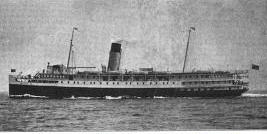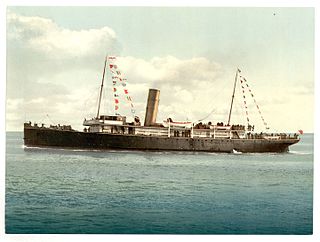
A paddle steamer is a steamship or steamboat powered by a steam engine that drives paddle wheels to propel the craft through the water. In antiquity, paddle wheelers followed the development of poles, oars and sails, where the first uses were wheelers driven by animals or humans.

PS Waverley is the last seagoing passenger-carrying paddle steamer in the world. Built in 1946, she sailed from Craigendoran on the Firth of Clyde to Arrochar on Loch Long until 1973. Bought by the Paddle Steamer Preservation Society (PSPS), she has been restored to her 1947 appearance and now operates passenger excursions around the British coast.

William Denny and Brothers Limited, often referred to simply as Denny, was a Scottish shipbuilding company.

PS Lincoln Castle was a coal-fired side-wheel paddle steamer, which ferried passengers across the Humber from the 1941 until 1978. She was the last coal-fired paddle steamer still in regular services in the UK. Later, she served as a pub at Hessle, and then as a restaurant under permanent dock at Alexandra Dock, Grimsby. In September 2010, the Hull Daily Mail reported that she was in an advanced state of demolition, despite the efforts of local people to buy the historic vessel and restore her. On 31 March 2011, the Lincoln Castle Preservation Society were reported to have purchased the broken up parts of the ship for restoration.

The Great Western Railway's ships operated in connection with the company's trains to provide services to Ireland, the Channel Islands and France. Powers were granted by Act of Parliament for the Great Western Railway (GWR) to operate ships in 1871. The following year the company took over the ships operated by Ford and Jackson on the route between Wales and Ireland. Services were operated between Weymouth, the Channel Islands and France on the former Weymouth and Channel Islands Steam Packet Company routes. Smaller GWR vessels were also used as tenders at Plymouth and on ferry routes on the River Severn and River Dart. The railway also operated tugs and other craft at their docks in Wales and South West England.

SS Princess Alice was a passenger vessel in the coastal service fleet of the Canadian Pacific Railway (CPR) during the first half of the 20th century.

SS (RMS) Douglas (III) – the third vessel in the line's history to bear the name – was a packet steamer which entered service with the London and South Western Railway in 1889 under the name Dora until she was purchased by the Isle of Man Steam Packet Company in 1901 for £13,500.

SS or RMS The Ramsey was a passenger steamer operated by the Isle of Man Steam Packet Company from 1912 to 1914. She had been built in 1895 as Duke of Lancaster for the joint service to Belfast of the London and North Western Railway and Lancashire and Yorkshire Railway companies. The steamer was requisitioned by the Admiralty in 1914 as the armed boarding vessel HMS Ramsey and sunk the following year.
TSS St Helier was a passenger vessel built for the Great Western Railway in 1925.
SS Ouse was a freight vessel built for the Lancashire and Yorkshire Railway in 1911.

TSS Malines was a passenger vessel built for the Great Eastern Railway in 1921.

TSS Prague was a passenger and freight vessel built for the London and North Eastern Railway in 1929. The first group of Kindertransport refugees to arrive in the UK did so aboard the Prague, in December 1938.

SS Dewsbury was a passenger and cargo vessel built for the Great Central Railway in 1910.
PS Duchess of Edinburgh was a passenger vessel built for the London and South Western Railway and London, Brighton and South Coast Railway in 1884.
SS Laura was a passenger vessel built for the London and South Western Railway in 1885.

PS Sandown was a passenger vessel built for the Southern Railway in 1934 and later served with distinction in the Royal Navy during the Second World War.
TSS Hantonia was a passenger vessel built for the London and South Western Railway in 1911.

SS Vera was a passenger vessel built for the London and South Western Railway in 1898.
TSS Lorina was a passenger vessel built for the London and South Western Railway in 1918.
SS Ardena was a minesweeper and escort vessel built as an Azalea-class sloop minesweeper for the British Royal Navy with the name HMS Peony in 1915.












